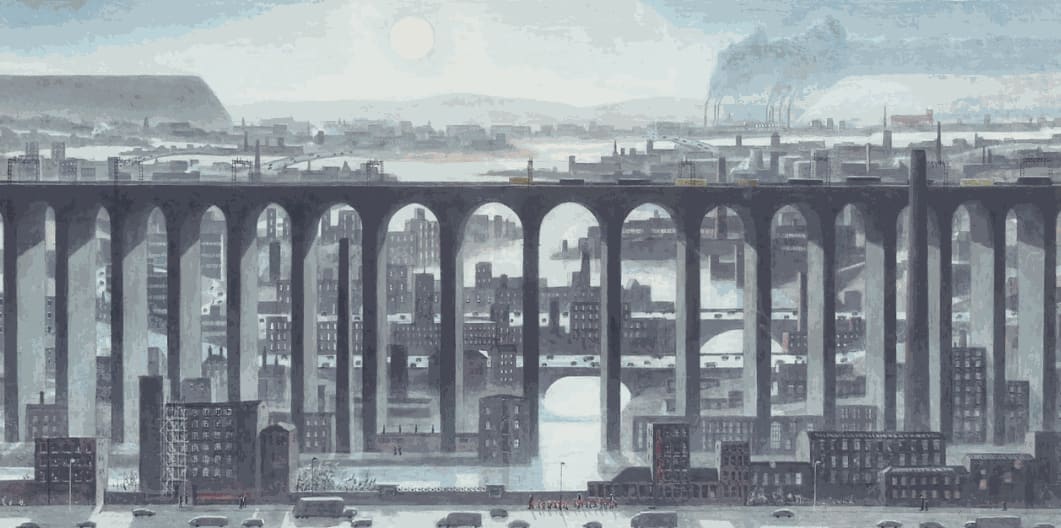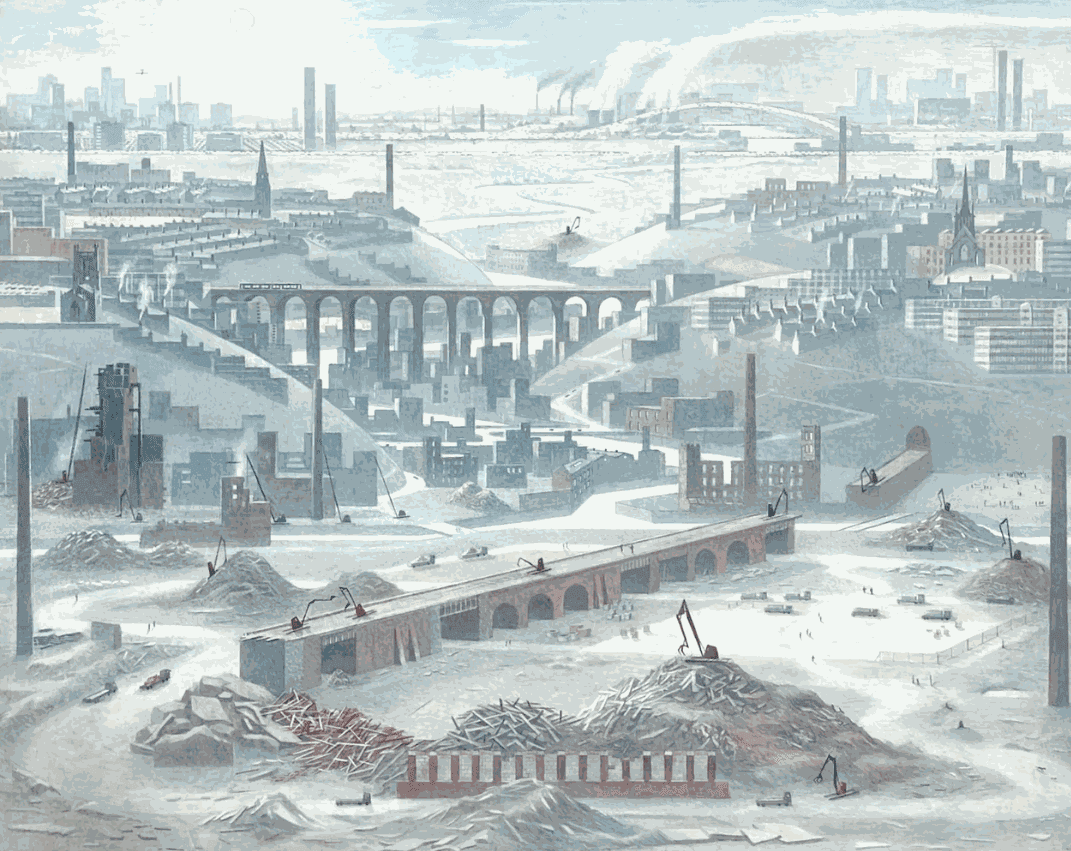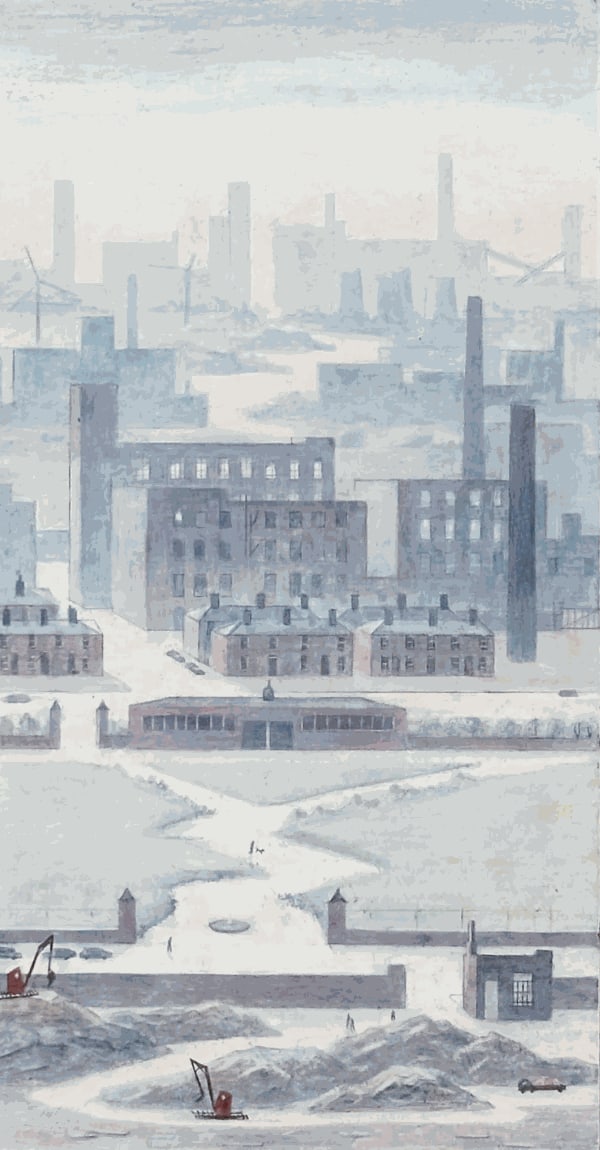Stockport’s streets, mill towers and riverbanks might not seem like obvious muses, but for Helen Clapcott, they offer something enduring. She isn’t just any British industrial landscape painter—her canvases, rendered in a method older than oil paint, slow you down. Using egg tempera, a medium most often associated with early Renaissance altar pieces, Clapcott captures modern England in a way that feels both grounded and strangely timeless.
In her hands, tempera’s precise marks and luminous sheen turn chimneys and rooftops into something quietly lyrical. The method might be ancient, but the result is anything but dated. Her paintings don’t just show Stockport, they seem to preserve it.
Who Is Helen Clapcott?

Born in the mid-20th century and trained at the Royal Academy Schools, Helen Clapcott has spent most of her life watching, recording and reinterpreting the architectural and natural landscape of Northern England. It’s Stockport, in particular, that keeps pulling her back.
She has, for decades now, focused on the edges, those in-between spaces where terraced housing gives way to chimneys, viaducts and overgrown riverbanks. Her work has a stillness, but it’s not empty. It’s contemplative, layered and full of a quiet tension.
As a Stockport artist, Clapcott doesn’t just offer a view, she offers a study. Every building, sky, and shadow is built through careful observation, her palette subtle yet unwavering. Her paintings often sit in collections across the UK, attracting those with a real appreciation for contemporary Northern art that still tips its hat to tradition.
And perhaps the most distinctive thing about her work? That would be the technique itself. Virtually all Helen Clapcott paintings are created using egg tempera—a rare choice for any egg tempera artist UK-based today, let alone one so committed to a specific place and narrative.
Helen Clapcott has been represented by Contemporary Six for years, giving collectors and enthusiasts access to her work in a way that feels both personal and trustworthy.
What Is Egg Tempera?

It might sound like something you’d find in a kitchen rather than a studio, but egg tempera is one of the oldest traditional painting techniques still in use. Long before oils took over, artists across Europe used this mixture of egg yolk, pigment, and water to craft everything from religious panels to illuminated manuscripts.
In fact, some of the most recognisable early works by artists like Botticelli and Fra Angelico were created with this medium. It’s fast-drying, almost stubbornly so, meaning every stroke has to be planned, layered, and repeated with purpose. There’s little room for reworking once the paint hits the surface.
The effect, though, is worth it. Egg tempera dries to a velvety matte finish and holds colour with extraordinary clarity. It doesn’t yellow or crack in the same way oils do, and in some respects, it allows a kind of precision that’s practically architectural. For any art using egg tempera, the result is usually luminous, finely detailed and full of surface tension.
For a tempera painting, Stockport-based artist like Helen Clapcott, that level of clarity and control seems entirely fitting, especially when every rooftop and viaduct line carries visual weight. The process itself isn’t forgiving, but in her hands, it rarely needs to be.
Why Clapcott Uses Egg Tempera

Helen Clapcott doesn’t just paint with egg tempera, she’s made it part of her identity as a British industrial landscape painter. Where other artists might chase convenience, Clapcott has chosen control. Egg tempera is fussy, inflexible, and brutally revealing, yet that’s part of its appeal. In a way, it reflects the very qualities she sees in the Northern landscapes she paints—sturdy lines, unpolished surfaces, and a sense of quiet persistence.
Her works often centre on places in transition, old mills dwarfed by modern flats, or industrial towers receding into wild green. These scenes don’t ask for sentimentality. They ask for structure. And egg tempera, with its capacity for sharp edges and clean layering, supports that structure in full.
In interviews, including one with Art UK, Clapcott has hinted that her affinity with the medium runs deeper than practicality. She appreciates the discipline it demands. Each painting begins with a detailed drawing, then multiple layers of tempera are applied, one wash at a time. The result is slow to build, but exacting. It suits her need for quiet focus.
So for a Stockport artist looking to preserve both mood and geometry, egg tempera isn’t just useful—it’s entirely aligned with her intent. It gives her the tools to render buildings not just as objects, but as lived-in spaces that still hold stories.
The Impact on Her Art
Helen Clapcott’s paintings don’t shout—they linger. That’s partly down to the subject matter, but equally, it’s the egg tempera. There’s something about the way the medium holds light that seems to steady the viewer’s gaze. Each surface whether slate rooftop or canal water, carries weight and clarity.
What’s interesting is how this very old technique brings out a distinctly modern stillness in her compositions. Egg tempera doesn’t smudge or blur the way oils do. It defines. And for a contemporary Northern art specialist like Clapcott, that definition becomes a kind of atmosphere. The detail isn’t fussy, it’s patient. Every line tells you where you are.
Collectors often remark on the tactile quality of her work. The surface isn’t glossy; it’s more like parchment or weathered stone. That tactile realism makes her Helen Clapcott paintings more than just visual, there’s an almost architectural presence. Buildings stand with subtle dignity, skies hold tension, and even empty roads seem to hum with something unsaid.
For anyone searching for a serious egg tempera artist UK based, one who can give traditional mediums new relevance, Clapcott’s appeal is hard to miss. Her work invites quiet attention, and rewards it. It’s art that asks you to look longer, not faster.
Helen Clapcott doesn’t follow trends. She follows structure, place, and memory, with a brush dipped in egg yolk and pigment. As a British industrial landscape painter, her commitment to traditional painting techniques gives her work a grounded depth. The medium might be centuries old, but in her studio, it’s a living, practical choice.
Her decision to paint with egg tempera isn’t about nostalgia—it’s about clarity, discipline, and respect for craft. That makes her paintings as relevant to serious collectors as they are to those who just want to see Stockport with fresh eyes.
If you’re drawn to art using egg tempera, or simply curious about one of the UK’s most distinctive regional voices in contemporary painting, contact us at Contemporary Six to explore the available collection.
